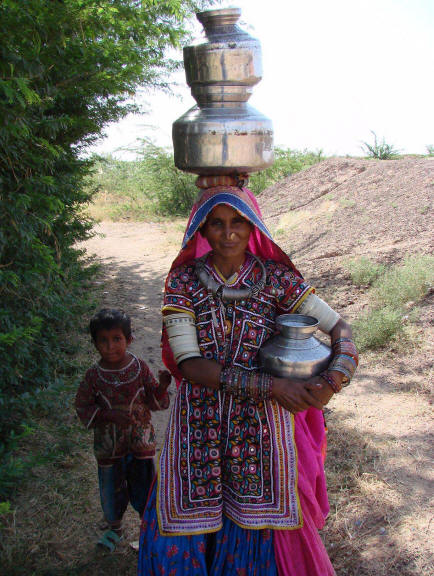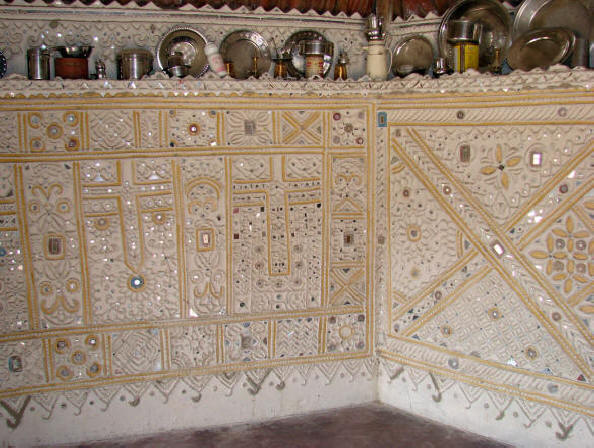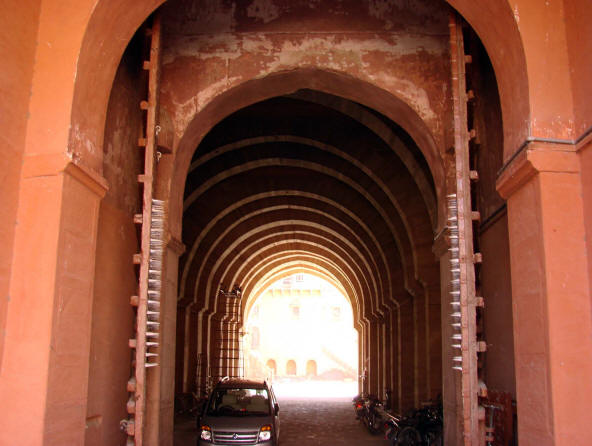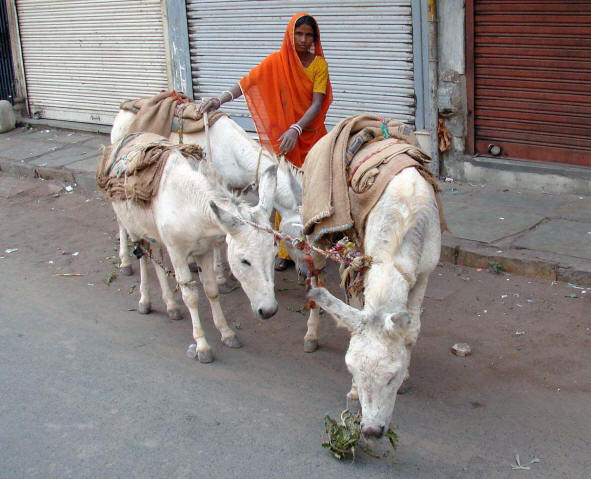|
Star Date: December 2008 |
||
|
Hello Dear Family & Friends! Kee I oo! Bada bad. (How are you? Fine. Kutch)
"Don't worry what the world needs. Ask what makes you come alive and do that. Because what the world needs are people who have come alive. Unless you do something from your genuine passionate
self,
from your calm, inner place, it won't help you or the (Howard Thurman) India. There aren't enough words in the English language to describe it. It is a land of superlatives, 'expletive deletives', esoteric floating adjectives and emotions oozing out of each encounter. Idiosyncrasies, inefficiencies and oxymorons make your experience with India one that will remain with you forever. To know India is to love and hate her all within minutes. Everyone reacts in differently and we each respond in ways never thought possible. The only thing for sure is that one can never spend time in India without changing. Change is inevitable, but here the button gets stuck on fast forward. Just hold on to your hat, buckle your belt, and hang on for dear life as you embark on the ride of your life. In the west when looking at a busy road, for example, we would see a steady stream of bright colored upscale cars and SUV's. Heaven forbid a run down clunker or motorcycle get thrown in. All vehicles are headed down the correct lane with cameras, lights, signs and policemen enforcing rules and directing the traffic. Now let's picture a busy road in India. It is a free for all. Within minutes of jaw dropping observation it is apparent that the caste system extends into the land of wheeled vehicles. This is an arena where the biggest stick rules. This pecking order starts with mammoth hurtling busses bellowing clouds of black exhaust, people hanging out of the doors and on top for dear life. They are battling it out with equally daunting kamikaze trucks sporting 2-3 blaring horns from behind fringe lined cabs with flashing lights, painted brightly with Hindu deities hoping to tip the scale of good luck in favor of these reckless, crazy drivers. Next down the line are the wealthy Brahmans on holiday in their shiny SUV's with drivers. They are vying for space with the newly arrived smaller budget cars of the middle class. Everyone drives with one hand on the wheel and one hand on their horn. The general idea of all of the above is that even though they are 'practice' driving themselves, if they blow their obnoxiously loud horns often enough and long enough all other forms of life will simply acquiesce the roads. HONNNNK! After all bigger and louder is better! Honking also translates " I am blowing my horn so I don't have to stop. Look out here I come!" Vehicles simply refuse to brake, giving right of way, because they know that if they don't fill the void ahead someone else will; maybe even someone from the other side of the road pulling a miraculous u-turn, driving the wrong way against traffic, then oozing into the spot. Possibly it's the shear numbers of 1.3 billion people but the flow of life in India never stops. Waiting for your turn is futile. Just take a deep breath, a giant leap of faith and merge. Motorcycles and scooters often loaded with whole families are a sight to rival even the Shanghai circus. Dad drives with 1 or 2 toddlers standing at his feet. Next comes Uncle, Grandma or teenagers, then wife 'sidesaddle in sari' carrying babies, bags, chickens, etc.. BEEP! BEEP! Lower forms of life to be pushed around are the auto-rickshaws who rule over the man-powered rickshaws; who in turn honk at simple peddle bicycles. They answer the horn mating call with hand squeezed bulbs that would have done Groucho Marx proud. Oxen pulled wagons, camel trailers, elephants, water buffalo, or pony carts trot along behind, dropping piles or trails on the road so they can find their way home. At the bottom of the heap, and subserviently dodging for their life are the lowly pedestrians. Crossing the chaotic streets of India makes sleeping on a bed of nails or walking over burning coals seem like a stroll in the park. It seems that as soon as one enters the arena of an Indian road a homing device or target is superimposed on each pedestrian. Forget marked crosswalks, they are mistaken for bulls eyes. It is as if an imaginary flashing light advertising the lucrative bounty on our head lures moving vehicles closer than ever imagined possible. It is nothing to get wedged between an ornery bull and a lop sided truck loaded beyond capacity, both bellowing with impatience. Policemen are ignored, holy sadus are driven up on the sidewalk, dogs escape within a hair of their tail but only the 'holiest of holies', the sacred cow calls the shots in this sea of confusion. These long horned, one humped bovines wander at will. Eating garbage, dropping 'splats' and sleeping smack dab in the middle of a busy intersection or roundabout is the norm. The roads are their kingdom. Bhuj, in the Great Raan of Kutch of Gujarat!
Where in the world is that? Stuck out on the seasonal island
of Kutch it requires days of travel to reach. Monsoon rains race
across the salty parched desert annually, cutting it off from the rest of the
state for months at a time. Continuing across endless sun baked desert south, Rajasthan blended into Gujarat, and we were happy to be visiting in Fall, rather than melting into the tarmac during summer. We sat next to Marari, a turbaned camel driver with a large mustache, who kept saying "Ah, Baba!" and proudly telling us of his 4 strapping sons, 3 ornery camels, 2 arguing wives, and 1 partridge, I mean "friend" in America. We headed south to Barmer, no hotels but one of the most fascinating bus stations to date. As with a lively market, it was a gathering point for villagers from the surrounding area, hanging out waiting for their bus home. A non stop parade of unique, colorful costumes and differently wrapped turbans. As soon as we sat down to wait for our bus we were surrounded by a minimum of 30-40 onlookers, a clue that tourists don't make it here often. Beautiful, enticing women peeked out from behind their veils while assertive husbands sporting flashy turbans made the arrangements. Not able to show their faces to strange men, I was able to get a few photos woman to woman, available to Joseph only in stealth mode. The solitary bus to Buhj left at 4:30pm to avoid the heat of the Little Raan Desert and our overnight ordeal was a blur of activity, stirring us up, packing us down and spitting us out at 3am on the dark streets of Bhuj. Staying in the old section of town, in the midst of the flurry of the Schoff Bazaar, was a great introduction to the many tribes people of Kutch, displaying the colorful costumes for which Kutch is famous. Hiding out from the scorching heat of the day, and marooned by rushing seasonal water and the ensuing knee deep mud for months on end, these creative villagers and nomads have perfected centuries old patterns and symbols in their weaving, unique tie dying and bright embroidery. It may take months to complete one intricate item, but they have the time and certainly weren't going too far anyways! Not yet infected with the virus of television and cell phones these resilient, independent villagers with a fierce history, spend their days talking, cooking, or working with their hands. The girls and women embroider or paint intricate designs on the side of their whitewashed round huts. The men tend cows or goats, carve wood bought from town or create elaborate mud and mirror designs on the inside of the huts. Within a few miles of Pakistan and thus needing a permit to visit northern villages (though never checked), we grabbed a public bus across the endless sun scorched salt flats. Like the surrounding dry, arid land Gujarat is a 'dry' state also requiring a permit to consume alcohol. One of the most entrepreneurial states in India, the Jains and other groups here and their relatives abroad, seem to have benefited from the lack of the pitfalls of alcohol. Business and alcohol or drugs just don't mix well. Men can actually converse here over a cup of 'chai' (tea), rather than getting drunk and acting stupid, as is the unfortunate trend of hard liquor bars springing up all over India. Swimming in a sea of colorful tribes people we started to discover the different designs and costumes that are exclusive to each village. Jumping off in Khavda, we followed a villager home to Ludiya, 2 km into the desert. Invited into his home we were offered tea, played balloons with the kids and took family photos. The vibrant costumes and heavy jewelry worn by the Meghwal women set your head spinning. Like stepping into a chapter of a book, the newly built mud huts were as flamboyant as their owners. Flattened by the 1991 earthquake, their village was rebuilt with the help of NGO's. New woodworking shops for the men, bathroom cubes, and a much needed cooperative store, with fair fixed prices for their embroidery items was built. The shop is closed due to lack of tourists so be aware of competition between artisan families. Be a smart traveler (again see below) and let yourself get caught up in the unique, intriguing village life of Ludiya. Women still wear bright traditional costumes, carry water from the well in jugs on their heads, and cook over wood fires. After a lengthy tea prepared over the fire outside, we were proudly shown their intricate handiwork and as is often the case after I admire their outfits, the women loved dressing me in their heavy clothing and jewelry from head to toe. One necklace of silver can weigh over 1 pound and that plus the restrictive top, skirt and scarf gave me a headache after several hours. I guess it is something you get used to. Not allowed to show their faces outside their home the women play a fascinating game of 'hide and peek' with their head scarves and veils. Interestingly enough their backs are completely bare, and the effect was quite seductive. We were invited into round hut (bhunga) after round hut to admire their colorful textiles, jewelry, crude woodworking, and intricate mud and mirror work on the interior walls. We bought a little item from each home and after we were offered a tasty lunch of chapatis and dahl we bargained hard for a unique embroidered border to add to a future skirt or blouse. Leaving before the glow wore off we retraced our steps across the desert and caught the next bus south. Getting off at a widening in the road 10 km south we sat in the shade of a chai shop and asked around for directions to the nearest village. Discovering it was 4 km inland through ankle deep dust (better than the ankle deep mud of monsoon) we were just going to hop back on the bus when a small exclusive tour bus full of Japanese tourists, visiting craftspeople of the area, pulled up. We said, "Ohio!" we are from Hawaii (which made us immediate celebrities) and is it possible to catch a ride into the village and back? They excitedly made room for us and we were able to enjoy a look at another desert village. Much poorer here, but these villagers were rich in the peaceful, simple surroundings of their colorful oasis set in this barren desert. The relentless sun had drained all our energy, even though we spent most of the day seeking out shade. As the long awaited coolness of the sunset brought relief we arrived back in Bhuj, thankful for a glimpse into the lives of these fascinating dwellers of the desserts of Kutch. A few days later a buzz was in the air as India's largest holiday, Dewali or Festival of Lights (like our Christmas/New Years), was celebrated. We strolled the light and candle filled markets and temples as the noise and pitch of excitement climaxed with one of the most bizarre displays of fireworks we have ever seen; and that's saying a lot after spending 14.5 months in China, the kings of fireworks. From our rooftop we saw no less than a dozen fireworks displays simultaneously within our 360 degree view. This amazing show went on for hours. It only got a bit scary when the family right next door lit the match, sending casings raining down on our heads after some of the explosions. We also followed at least half a dozen 'boomerang' fireworks go up and instead of exploding they made a horseshoe back to their owners, only to explode near home! In this land of extremes, we just observe such events with awe and don't let our minds start thinking of dangers, logic, etc. One would go crazy at times. Just go with the wild, irrational flow and enjoy the ride. (We did place ourselves next to the stairs just in case a mad dash was in order). We also
roamed the ghostly cob web and dust filled remains of Prag and
Aina Mahal. Even with the massive cracks in the structures,
chipped chandeliers, and broken gold painted statues these colossal
palaces from the 1700's are attention grabbing in a macabre sort of
way. They are painful reminders of the devastating 2001
earthquake that killed 150,000 people and destroyed much of the rich
cultural heritage of this frontier town, India's wild west, and
surrounding area. The city's physical and psychological scars
are slowly healing and while having one of my pleasant mid day chats
with Ranju, the woman who proudly owns and operates Senoritas
Boutique, I brought up the terrible event. She had just opened
her shop around 9am and all of a sudden the whole world started
crashing in on her. She had the sense to run into the street
just as her shop, constructed of bricks and stones, collapsed.
She lost everything, without compensation, as is the case here.
She is thankful she survived, unlike her many friends, family, and
neighbors who weren't so fortunate. Maybe that is why, even in
the aftermath of such suffering Ranju always has a shy but warm
smile waiting for anyone who stops in her little shop. Only Ahmedabad, the largest city of Gujarat, with it's congested streets gives you the feeling you are in mainstream India. In the rest of the state, especially in the remote villages, one feels like a voyager observing new areas of India. Although a hectic place, we were the only westerners we saw in Mandvi; a coastal village where they build magnificent wooden cargo ships, up to 200 feet long, for use by merchants in the Middle East, far across the Arabian Sea. We spent the afternoon in complete seclusion on a pristine, private beach after climbing over walls, following the maze of paths complete with wild camels and through the forest in front of Vilas Palace (a typical 'Gill Tour' ala Joseph). Continuing south towards Diu, we bumped along as the only road crawled through the Sasan Gir Wildlife Sanctuary, the last refuge of the Asiatic lion. These hilly savannah-like 1400 sq. kilometers are also home to leopards, hyenas, crocodiles, parrots, monkeys, deer, etc. and have seen success in saving these famous cats. Their numbers have increased from under 200 to over 325 lions in 2004. As populations increase with both the lions and the neighboring nomadic herders they are starting to compete for food and trees for fuel. Lions are targeting young calves outside the reserve and one lion was even spotted on the beaches of Diu. They are far less a hassle than herds of annoying drunken male tourists partaking of the only booze in the dry state of Gujarat. Joseph found out the painful way that broken bottles and beaches don't mix. After so looking forward to swimming in the ocean following months in the dry desert Joseph sliced his foot open within 5 minutes of setting foot on the sand. We were assisted by helpful locals every step of the way, from a cloth to wrap his bleeding foot, to a ride on the back of a motorcycle to the old church acting as a emergency clinic and finally to the hospital. Full of sand, Joseph was told to wash his foot out at the hose outside. It then took 2 nurses to pull on the needle to put the 5 stitches in the tough ball of his foot. Free patch up jobs are available, by competent physicians, to anyone who walks or limps through the door. We always make sure to watch carefully that new, sterile items are used in any procedure. Public hospitals with dizzying, endless lines of patients may still wash out and reuse latex gloves or hand make gauze dressings for instance, while other hospitals in India have state of the art facilities. It is common to talk with an impressive doctor who was trained in London or the USA. Sum total cost for Joseph's visit, including antibiotics = zero. Try that one back home, where many nasty germs are contracted during stays in our sterilized hospitals. A former Portuguese colony until 1961, this small island of Diu is a perplexing place for those seeking a holiday by the ocean. The beaches between Sunset Point and Jallandhar Beach are clean and free from crowds, but be careful of the sharp rocks at low tide. The sunsets along the ocean are spectacular, and along with the old cathedrals and narrow balcony lined streets of the Portuguese old town make up for the lack of seaside amenities. Sultans, Mughal emperors, the Ottomans, the Turks, and finally the Portuguese, have all vied for control of this obscure but strategic little island. Who would have thought the victors would be crowds of Indian tourists enjoying their day at the beach? Best Signs seen in India: Near a mosque: "Precision circumcision". Marshesh Furnishings "We are Here!" Jewelry
store: "The
Latest in Guaranteed Genuine Imitation Jewelry". Road sign: "Be Gentle on My Curves". "Your destiny awaits you - only 3.5 kms. ahead!" (Just think of all the self help books and workshops we could skip). "A small store of little profit."
And so it goes.........................................Next time the state of Maharashtra with its ancient hand carved caves of Anjunta and Ellora and the megalopolis of Mumbai. Thanks for taking the time to learn more about the wonders of western India. CNN only reports headline news about the tragedies of devastating earthquakes or the criminal attacks on Mumbai. There is so much more. Until next month Keep Smiling and remember to take time in 2009 to find your true passion in your calm, inner place. Act from that place and Come Alive! We are glad you stopped by. Thanks for keeping in touch and for sharing this webpage with anyone you think would be interested. The number of our readers is growing each month thanks to you. Take care!
Love, Light &
Laughter,
Travel notes: $1.00US = 50 Indian Rupees. These prices were at the height of India's busiest season, Dewali. Arrive by Thursday (prices go up on the weekend) bargain hard and know that prices go down at other times. Bhuj: Hotel Gangaram: Senorita's Boutique: woman owned and operated - Main Bazaar, Darbargath. Small shop full of piles of hand printed material from which to have something sewn up. Drop in to get one of Ranju's friendly smiles. Green Restaurant: Down a side alley off the Main Bazaar. Great thali plates at noon. Ludiya: Village north of Bhuj. Take the bus almost to Khavda, ask to be let out on the dirt road to Ludiya (1 km. before Khavda.) Walk about 2 km. and when you reach the big sign announcing Ludiya on your right, head left past the pastel little temple and walk straight to the back of the village. Immediately women will come out of their huts wanting you to look at their handiwork. Come prepared to buy a few small items such as dolls for 10r or a border of embroidery for 50r. Buy one thing from each house, (maybe 3 huts max). Some craftswomen are definitely more talented than others, so look around. If you find a bigger, more expensive item that catches your eye bargain hard, (after first finding the price range back in Bhuj before you set out). Take photos of the fascinating costumes while you are a possible buying customer. Enjoy being dressed up by the ladies. Observe life in their village. Make it short and sweet. Smiles may disappear and the hard sell begins once they discover your wallet won't provide them with the money they covet. But by then you just head back down the road, still excited by the whirl of activity you have just experienced. The huts in front of the village (to the right of the temple) are pushy and ruin the mood. They tried to avoid the inevitable competition by setting up a cooperative with fixed prices but lack of business has shut it down. Other villages run cooperative stores but they are harder to reach, without your own transport. Taking a scooter across the desert salt flats is enough to fry your brains - so Ludiya is still a good place to visit by bus. Can't beat the costumes. Mandvi: Vilas Palace: Take a rickshaw out (50r)
and after a look at the estate just head straight towards the
ocean, following the maze of dirt paths. At some point you
will have to climb over the gates of the large wall surrounding the
palace. It's worth the long, hot walk as a cool dip awaits you
on this private, pristine beach. Sometimes they have a little
table charging 50 r to swim but mostly they collect only if you
enter at the other end - the tented hotel where you can enjoy a
drink on the beach. (Lunch is only open 12-3pm, 150r for curry).
Walk the loop through the 'hotel' back to the main road and catch a
auto rickshaw or hitch hike back to town if it's late in the day. Diu: Forget Sea Village Resort above Sunset Point, except for a cool drink on a hot day. Basically overpriced, grimy steel roof shacks and a greasy restaurant. Location only keeps them open. A to Z Computer Cyber Cafe and Tour Agency: Husain and his wife are very friendly, helpful and professional in this well run business. (located in the old town). Palitana: Ahmedabad: For a quiet hideaway along the far side of the river don't miss Sabarmati Ashram, Gandhi's home for over 10 years. Many mosques, with symmetrical minarets of varied styles grace the skyline of Ahmedabad. One such 'shaking' minaret, resistant to earthquakes, was partially dismantled by an inquisitive Englishman in a ridiculous show of Imperialism, to see how it worked. He never did. Having endured many earthquakes throughout the centuries, it collapsed with the next tremor. Sunrise Restaurant: Opposite Kalupur Railway Station, excellent vegetarian food in clean, upscale surroundings. Accommodating service, right down to the vertically challenged midget door man. Phone #221 45601.
|
|
|


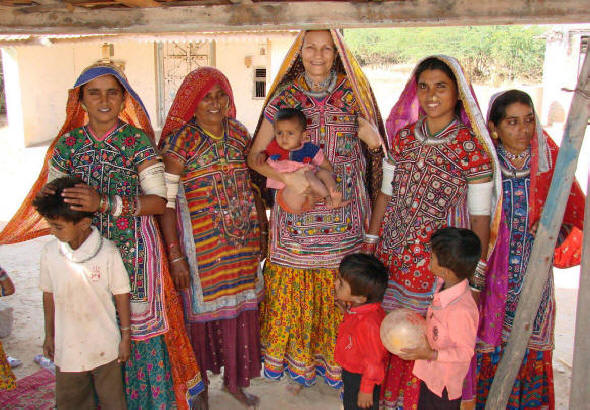 For some reason the ladies love
dressing me up.
For some reason the ladies love
dressing me up.